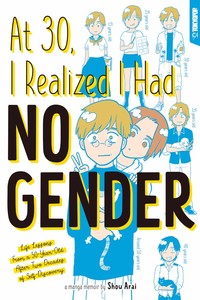Review
by Rebecca Silverman,At 30, I Realized I Had No Gender
Manga Review
| Synopsis: |  |
||
Intersex transgender manga creator Shou Arai lived the first thirty years of their life as a woman before discovering that that wasn't really a comfortable description. After discovering transitioning to presenting as a man and learning that he's physically intersex, Arai and his boyfriend have settled into a comfortable life. In this volume, they reflect on their experiences so far and answer questions from friends and readers about LGBTQIA+ life in Japan. At 30, I Realized I Had No Gender is translated by Massiel Gutierrez and lettered by Vibrraant Publishing Studio. |
|||
| Review: | |||
There's a lot that we don't always know about ourselves. Sometimes, that's because we genuinely don't know something genetic about our bodies, as happened to creator Shō Arai, who discovered that he's intersex via chromosomal testing at age thirty. But even when we're pretty sure who we are and who we are or aren't attracted to, there are discoveries to be made, and our lives can be works in progress even with the big details hammered out. Arai's English-language debut At 30, I Realized I Had No Gender isn't his first autobiographical manga, but it is something of a rarity in terms of what we tend to get in translation: it's about aging as a queer person and being comfortable with the changes that come along with it. Despite the title, the story is set around the time of Arai's fiftieth birthday. His boyfriend is younger (and looks even younger than he is), so age differences between partners are one of the topics explored. But this is a reasonably wide-ranging book for one so short, and it covers a lot of territory, from sex to facial hair to the frustration of gendered language. The book does open with a brief note about that last one – while Arai briefly mentions in the text that he uses masculine pronouns after having considered they/them, mostly the language is aligned with Japanese terminology, which has some differences from English in terms of what's considered polite/correct. There are a few moments when it's good to have that little bit of information, but for the most part, Arai explains his viewpoint with perfect clarity, regardless of what words are being used. Although the book doesn't carry a mature rating (which I appreciate; rating informative LGBTQIA+ books or educational books that happen to deal with sex M keeps them out of the hands that need them), there are plenty of frank discussions about sex, and some uncensored (but also nongraphic) depictions of male genitals. I wouldn't call them gratuitous at all, although they may take some readers aback if you aren't expecting a step-by-step guide to teaching a trans friend how to top his aging boyfriend so that they can both enjoy sex. Because this is a book about middle age, there are explorations of how an age gap between partners can impact their sex life or even just how bodies of all genders change as they age and what that means for sexually active people. It's an excellent discussion, as is one reader question Arai answers about his boyfriend's testicular health. It's all less educational and more affirming to see such grounded and open conversations about topics that people are often uncomfortable discussing. (And it's balanced out by Arai's love for his boyfriend's penis, which is much more goofily presented.) A lot of space is devoted to the specific issues queer or gender nonconforming people may face in Japan without getting into a topic like marriage. (For that, pick up Why I Adopted My Husband.) For example, a hot spring poses problems, or at least questions, for trans or intersex people, who may be unable to use the spring matching their gender identity. In contrast, the strict gender binary still largely in use presents difficulties for people who aren't part of it. Some of it is as basic as how to refer to your significant other – do you use traditional gendered terms, such as "danna" or "oku-san," or stick with less permanent-sounding words like "boyfriend" or the neutral "partner?" Arai also notes that bias against nonbinary people can make it challenging to be honest with those around you, and he also answers questions about breast-binding and growing facial hair, or at least making it look more impressive with makeup. Even if it isn't an issue for you personally, they're all interesting conversations, and learning about things others struggle with can only make us more understanding. Like many autobiographies in manga form, the art isn't the main draw. Arai's art is cute and pleasant, and he has a way with the inappropriate chibi that is entertaining, but the four-panel style doesn't necessarily help with story flow, and there are places where this drags a bit. It's also clear that this is the latest in a series of autobiographical manga, which sometimes means that we're missing a big chunk of Arai's story. Hopefully, this does well enough to merit bringing the others over because At 30, I Realized I Had No Gender is the open, frank, and honest discussion that sticks with you. If you're looking for a book that doesn't hold back and just speaks its mind about its creator's experiences as a human being, definitely pick this up. |
| Grade: | |||
|
Overall : B+
Story : B+
Art : B
+ Open, honest, and frank about a variety of topics related to aging and being queer. |
|||
|
discuss this in the forum (1 post) |
this article has been modified since it was originally posted; see change history |
|||
| Production Info: | ||
|
Full encyclopedia details about |
||